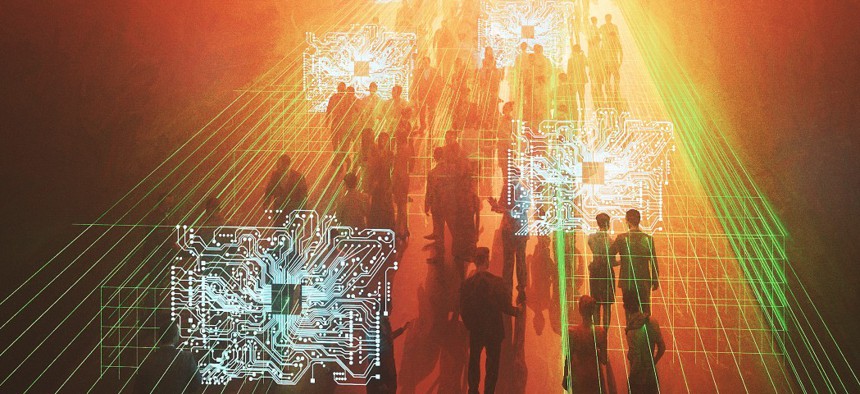IARPA Project Aims to Identify People from Drones by More Than Just Their Face

gremlin/Getty Images
“It'll be interesting to see in a year or two from now,” according to the program manager.
The intelligence community’s key research arm recently moved to develop biometric software systems that can identify people’s entire bodies from long ranges in challenging conditions.
Through this newly unveiled multi-year research effort—called the Biometric Recognition & Identification at Altitude and Range or BRIAR program—the Intelligence Advanced Research Projects Activity is working with teams from multiple companies and universities to pave the way for next-level recognition technology.
“There's such a diversity of technical challenges that are trying to be addressed. This is tackling a problem that's important for the government and for national security—but I think is underrepresented in the academic research because it's not a topic focus area,” IARPA Program Manager Dr. Lars Ericson told Nextgov on Wednesday. “You need to have government involvement to stimulate the data, and the research, and the evaluations in this topic area. So, I think that there's a lot of potential for broad benefits to biometrics and computer vision, while also driving towards this very important government mission capability.”
Ericson’s background is in physics, as well as biometrics applications and technologies. He oversees IARPA’s biometrics portfolio of research efforts.
As one of the latest programs to kick off, BRIAR’s ultimate aim, according to a broad agency announcement released last year to underpin this work, is to “deliver an end-to-end [whole-body] biometric system capable of accurate and reliable verification, recognition and identification of persons from elevated platforms and at distances out to 1,000 meters, across a range of challenging capture conditions.”
The software algorithm-based systems could one day support the intelligence community and Defense Department components in pinpointing people from watchtowers or drones, particularly in conditions that make observations extremely difficult.
Ericson noted that the current state-of-the-art technology in this realm really hasn't advanced to the point of being able to properly address certain biometric needs from an accurate and reliable standpoint in certain challenging imaging conditions.
“My IC partners, because of their missions, are interested in being able to do biometric identification tasks,” he said.
Considering best case scenario outcomes of this work, he said IARPA intends to develop, “that fundamental deliverable capability,” and also contribute “to the scientific understanding and knowledge in the research community, such that we can further push computer vision and biometrics research and scientific understanding to greater benefits for all scientific community.”
After releasing the broad agency announcement for BRIAR last year, IARPA awarded research contracts to teams from: Accenture Federal Services LLC; Intelligent Automation, Inc.; Kitware, Inc.; Michigan State University; Systems & Technology Research, the University of Houston; and the University of Southern California.
“Those seven teams are all pursuing the same ultimate end goal,” Ericson explained.
The BRIAR BAA is broken down into multiple technical challenges and objectives to give a greater focus and clarity to the researchers involved, he added.
“They include things like long range and high pitch, but they also include other technical objectives that are part of the overall system—for example, being invariant to the pose and illumination and expression of the individuals that are being imaged, to not be dependent on the clothing that this person is wearing, so it is a true biometric signature that’s being extracted from the imagery, as well as an explicit goal of making sure that the systems perform equitably across diverse demographic and human body shape groups,” Ericson said.
Carnegie Mellon University and General Electric Research were also selected for more “focused” research contracts to support IARPA in this effort.
“Those two teams had some very creative and innovative ideas in a subtopic within the overall program, and so they have more specialized objectives that they're pursuing,” the program manager noted.
Officials from the Energy Department’s Oak Ridge National Laboratory, the National Institute of Standards and Technology and the U.S. Army Combat Capabilities Development Command will provide testing and evaluation for this work.
“It'll be interesting to see in a year or two from now,” Ericson said. “Follow up to see what has been accomplished—but at this time, there's a lot of promise and a lot of excitement about these teams and what they are positioned to try and pursue.”






